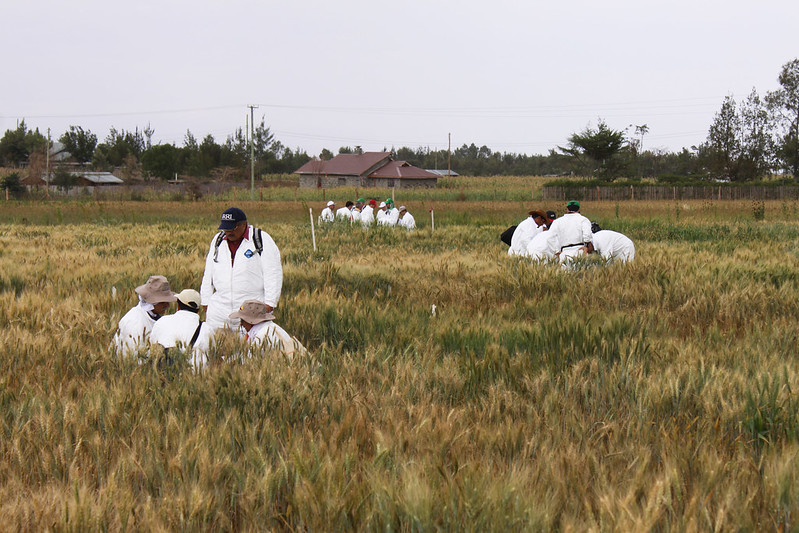Dave Hodson highlights “major breakthroughs” in rust disease response at the 2020 Borlaug Global Rust Initiative Technical Workshop
By Madeline Dahm
Dave Hodson, principal scientist at the International Maize and Wheat Improvement Center (CIMMYT), examined over a decade of progress from global partners in the battle to detect and respond to global wheat rust diseases at a keynote address at the Borlaug Global Rust Initiative (BGRI) Technical Workshop in early October.

Rust response in the 2000s: sounding the alarm
When the first signs of Ug99 – a deadly strain of wheat stem rust – were noticed in Uganda in 1998, farmers and researchers did not understand the full threat of this disease, or where it would travel next. After Nobel Prize-winning breeder Norman Borlaug sounded the alarm to world leaders, the BGRI was formed and stakeholders from around the world came together to discuss this quickly growing problem. They realized that first, they must develop effective monitoring and surveillance systems to track the pathogen.
Starting in 2008, the initial vision for the global rust monitoring system was developed and the first steps taken to build the global rust surveillance community. Expanding surveillance networks requires a strong database, increased capacity development and well-established national focal points. With standardized surveillance protocols, training and GPS units distributed to over 29 countries, data began to flow more efficiently into the system. This, combined with a preliminary study of the influence of wind and rainfall patterns, improved scientists’ ability to predict areas of higher risk. Furthermore, the group knew that it would be key to integrate race analysis data, expand access to information and eventually expand the system to include other rusts as well.
“Fast forward to today, and we’re now looking at one of the world’s largest international crop disease monitoring systems. We have over 39,000 geo-referenced survey records from >40 countries in the database now, and 9500+ rust isolate records,” said Hodson.


Implementation of the Durable Rust Resistance in Wheat (DRRW) and Delivering Genetic Gain in Wheat (DGGW) projects – predecessors to Accelerating Genetic Gains in Maize and Wheat for Improved Livelihoods (AGG) – and other key projects advanced this surveillance system, providing early warnings of potential rust epidemics to scientists and farmers.
An important part of this success comes from the Global Rust Reference Center in Denmark, where scientists have put together a state-of-the-art data management system, known as the “Wheat Rust Toolbox,”; providing a flexible centralized database, rapid data input from mobile devices, data export and a suite of database-driven display tools. The system is flexible enough to handle multiple crops and multiple diseases, including all three wheat rusts.
A united front
Another critical element to this surveillance system is a global network of rust pathotyping labs around the world.
“We currently have good surveillance coverage across the world, especially the developing country wheat-growing areas,” says Hodson. “Coupling sampling from that survey network to these labs have enabled us to track the pathogen.”

This is particularly important in the face of a rapidly mutating pathogen. Not only are new variants of Ug99 appearing and spreading, but also other important new races of stem rust are being detected and spreading in places as far-flung as Sicily, Sweden, Siberia, Ecuador, Ethiopia and Georgia. In many regions, we are seeing a re-emergence of stem rust as a disease of concern.
“We now know there are 14 races of Ug99 confirmed across 13 countries. We have seen increased virulence of the pathogen, it is mutating and migrating, and [has] spread over large distances.”
Furthermore, yellow rust has emerged as a disease of major global importance. The spread of yellow rust and appearance of highly virulent new races seems to be increasing over time. Several regions are now experiencing large-scale outbreaks as a result of the incursion of new races. For example, in South America, causing one of the largest outbreaks in 30 years.

Major breakthroughs in prediction and surveillance
Despite the increased spread and virulence of wheat rusts, the global community of partners has made serious advances in prediction, tracking and treatment of pathogens.
The University of Cambridge and the UK Met Office have developed advanced spore dispersal and epidemiological models for wheat rusts, resulting in a major leap forward in terms of understanding rust movements and providing a foundation for operational, in-season early warning systems. Operational, early warning is already a reality in Ethiopia and similar systems are now being tested in South Asia.
“These models are actually able to predict many of the movements we are now seeing globally,” says Hodson.
“In Ethiopia, information is going out to partners in weekly advisories, as well as targeted SMS alerts using the 8028 farmer hotline developed by the Ethiopian Agricultural Transformation Agency (ATA), with over 4 million subscribers. It makes it possible to get ahead of the disease in key areas–a major breakthrough,” he said, noting plans underway to expand the system to more countries.
In addition, innovative diagnostics such as the award-winning MARPLE rapid, field-based diagnostic tool developed with the John Innes Centre and Ethiopian Institute of Agricultural Research (EIAR), are transforming the time it takes to detect potentially damaging new races. Resulting in more opportunities for early warning and timely, effective control responses.
The future of wheat research and disease management
“Clearly, we’re going to need more multidisciplinary approaches to combat these increasing threats from transboundary diseases,” he says, though very optimistic for the future of wheat rust disease forecasting, early warning systems and diagnostics.
Thanks to a “truly fantastic” global community of partners and donors, the global scientific community has built one of the world’s largest crop disease monitoring systems to track and combat aggressive, rapidly spreading wheat rust diseases. Its continued success will depend on embracing state of the art technology – from molecular diagnostics to artificial intelligence – and developing a plan for long-term sustainability.





